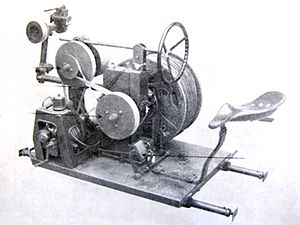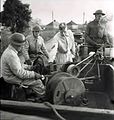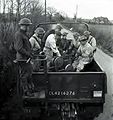Cable Layer Mechanical No 1
From RCSigs.ca
| Cable Layer Mechanical No. 1 | |
|---|---|
 | |
| Production history | |
| Introduced | 1938 |
In 1937, the Director of Mechanization, War Office, sent Colonel Forde some photos and the following description of this new device.
- The apparatus consists of a small I.C. (internal combustion) petrol engine of about 1 to 1 1/2 h.p. which drives through a leather belt an adjustable pulley. From the adjustable pulley the drive is taken through another belt, the tension of which is controlled by the movement of the pulley, to a patent spewing roller.
- The standard cable drum (drums cable No. 7) is carried on a steel spindle mounted on ball bearings and fixed at one end only.
- The cable is led directly from the drum to the spewing roller through two guides. It is held against the roller which is rummber faced by an upper roller which is spring loaded, the tension being adjustable. It has been found in practice that the drum is revolved without difficulty by the tension on the cable and the cable insulation appears to suffer no damage as a result. Either single or twisted cable can be used. Wear occurs on the rubber facing of the roller but this is easily removed and replace when necessary.
- For reeling in, the belt is removed from the spewing device and drives a pulley connected directly to the drum spindle.
- The movement of the adjustable pulley is controlled in a very similar way to the control of the belt tension on the cable wagon.
- The apparatus is made in 2 parts. The lower consists of a metal platform with end jacks to permit of its being held rigidly against the side of load carrying vehicles of different width. The upper portion containing the drum spindle, petrol engine and spewing device, together with a seat for the lineman operating the layer, is pivoted on the lower platform and can be held in three positions, i.e. to lay out on either side of the vehicle or to reel in over the centre of the tailboard. The man using the crook stick is carried in a metal cage which is hung on the tailboard of the vehicle on whichever side cable is being laid.
- The apparatus is designed for carriage primarily in a 30 cwt. 6-wheeled G.S. lorry, but can be carried in other types of load carrying vehicles. For satisfactory cable laying is is desirable that the distance between the spewing roller and the lineman using the crook stick should be as great as possible and vehicles with very short bodies are, therefore, unsuitable.
- Cable can be laid out and reeled-in at speeds up to 20 miles per hour:
- The whole apparatus can be quickly installed in, or removed from, a vehicle by the crew.
Related Pages
- Cable Laying with a Cable Layer Mechanical No 1 WW2 Video
- Description and Operating Instructions for Cable Layer Mechanical No. 1
Related Items
References
.






